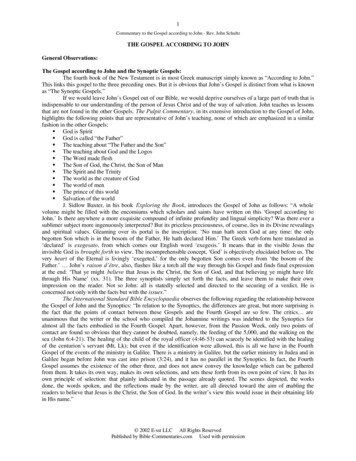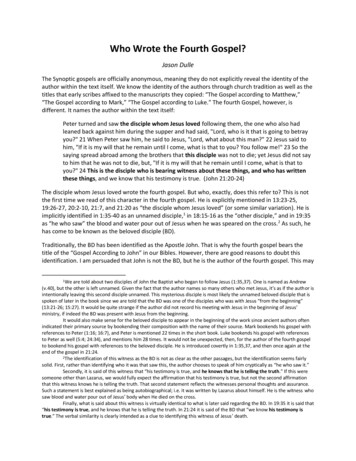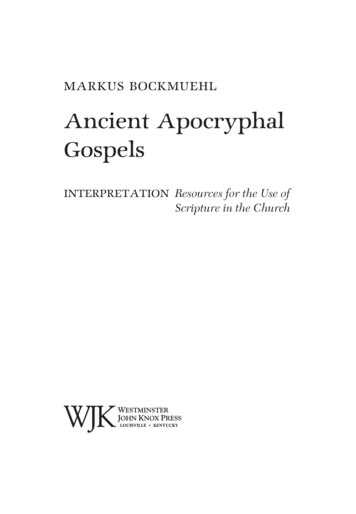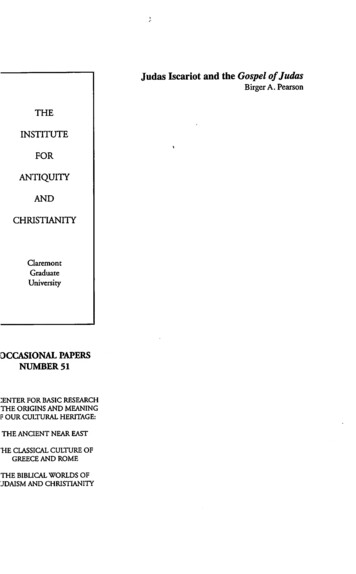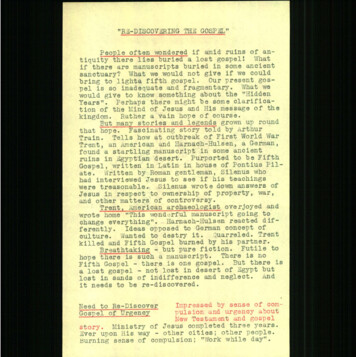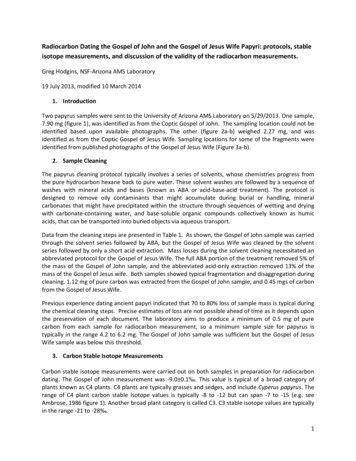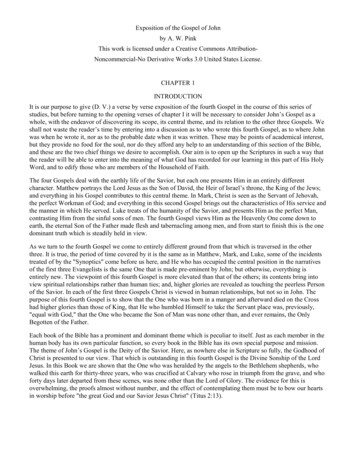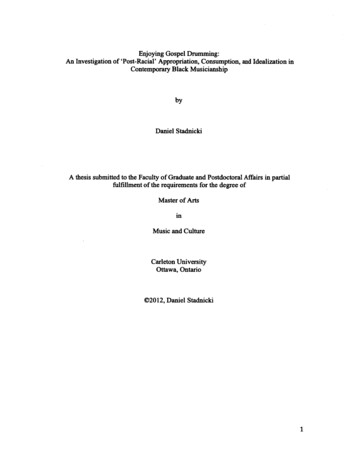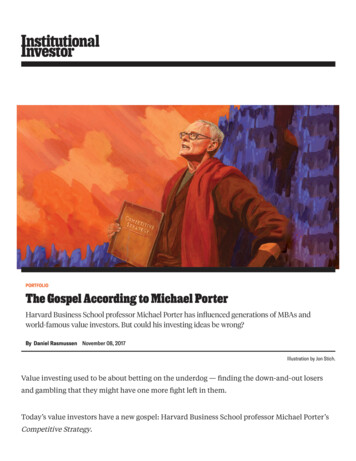
Transcription
PORTFOLIOThe Gospel According to Michael PorterHarvard Business School professor Michael Porter has influenced generations of MBAs andworld-famous value investors. But could his investing ideas be wrong?By Daniel Rasmussen November 08, 2017Illustration by Jon Stich.Value investing used to be about betting on the underdog — finding the down-and-out losersand gambling that they might have one more fight left in them.Today’s value investors have a new gospel: Harvard Business School professor Michael Porter’sCompetitive Strategy.
Porter’s theory is that power leads to profits. The wider the moat, the greater the market share,the greater a company’s ability to squeeze profits from competitors, suppliers, and customers.Porter tells a modern parable of the Five Forces — the professor’s signature analysis framework— that gave Goliath a sustainable competitive advantage over David.But the founder of value investing, Benjamin Graham, was a poor Jewish immigrant who madehis name betting on the Davids of the stock market. The legendary Graham believed thatinvestors could make money by betting against consensus when that consensus went againstthe numbers.There is perhaps no greater gap between consensus and numbers today than in the applicationof Porter’s competitive strategy to investing. Unlike Graham’s quantitative methodology, whichhas endlessly been empirically proven, Porter’s competitive strategy principles have noempirical foundation. There is simply no evidence — not a single quantitative study — tosupport his conclusions.Is it possible that the consensus view of competitive strategy, taught at every businessschool in the country, just isn't right?Porter has “influenced more executives than any other business professor on Earth,” accordingto Fortune, and “redefined the way that businessmen think about competition,” says TheEconomist. Generations of Harvard MBAs have embraced a creed that celebrates “barriers toentry” and the power of an advantaged establishment. Warren Buffett says in interviews that helooks for companies “with durable competitive advantage” — “castles with moats.” BruceGreenwald, who teaches value investing at Columbia University, argues that investors shouldinvest in companies with “incumbent competitive advantages” and “the protection of barriers toentry.”This consensus around Porter’s ideas in the value investing community is jarring given howcontroversial those theories are elsewhere. Economists at the University of Chicago havethoroughly disproven any connection between market share and profitability; antitrust law once
thoroughly disproven any connection between market share and profitability; antitrust law onceassumed that high market share was necessarily anticompetitive, but the courts abandoned thatidea in the 1980s as lacking an empirical foundation.Porter maintains that “the fundamental investor that uses the Five Forces to understand whatdetermines the fundamental economic value creation in an industry and how it is changinggains a huge edge.” But that edge hasn’t been much in evidence of late, as fundamentalinvestors have grappled with years of underperformance and fund outflows.Instead, the edge seems to be with Porter’s ideological opposites at the University of Chicago.The Chicago school is known for eschewing theory in favor of rigorous empirical research, andits research has found that the best-returning stocks are the small value companies like thoseGraham invested in, rather than the large market leaders that Porter’s analysis favors.This evidence-based approach to investing has been winning the battle for dollars and alpha.Dimensional Fund Advisors, co-founded by Chicago’s Eugene Fama, is the fastest-growingmajor mutual fund company in the country, with two thirds of its funds beating theirbenchmarks. Other Chicago school investors, from Cliff Asness at AQR to Wes Gray at AlphaArchitect, have seen similar results. But despite the evidence, fundamental value investorsremain enamored of Porter’s ideas. When they talk about market leaders, market share, marketposition, competitive advantage, and barriers to entry, they are, sometimes unwittingly,embracing Porter’s view of strategy. Is it possible that the consensus view of competitivestrategy, taught at every business school in the country, just isn’t right?Michael Porter is perhaps the most intellectually gifted business school professor of hisgeneration. His colleagues at Harvard Business School speculate that had he chosen to studyeconomics rather than business and industrial organization, he might have won a Nobel prize.His prominence, and rate of citation, merit such praise. (Porter did not respond to a request forcomment.)Yet Porter did not choose to study economics. Rather, he elected to study business, an academicfield in which knowledge is still derived primarily from case studies rather than fromeconometric analysis and where many professors strive to develop theories that will resonate incorporate boardrooms rather than scientific academic journals.
Porter’s first major publication would come to define his career. He staked out his position in a1979 Harvard Business Review article, “How Competitive Forces Shape Strategy,” and in his 1980opus Competitive Strategy. Porter declared that the end goal of strategy is to capture “excessprofits,” which arise from the structure of industries, and that there are “Five Forces” that shapethis structure: the bargaining power of suppliers, the bargaining power of buyers, the rivalryamong existing firms, the threat of substitute products, and the threat of new entrants.The stronger the sum of these forces, according to Porter, the less profitable the industry will be.The task of professional managers, then, is to position their firms in ways that exploit the factthat “the weaker the forces . . . the greater the opportunity for superior performance.”Porter’s idea of competitive strategy emerged from the work of University of California professorJoe Bain, who developed a theory he called structure, conduct, and performance. Porter’s Ph.D.adviser at Harvard, Richard Caves, was a student of Bain’s, and Porter’s theory is at heart areframing of Bain’s ideas. Porter presents market power and barriers to entry as the end goals ofcorporate strategy rather than as problems requiring government intervention to solve.Bain believed that profits followed from power, and that power could be measured by marketshare. If one company controlled 70 percent of a market, that company could use its power togenerate higher margins than a weaker company that controlled only 30 percent.Bain argued that these powerful businesses solidified their profits by erecting barriers to entryto prevent new competitors from entering the market and offering lower prices that woulddilute the profits that resulted from market power. In his view, advantages such as market share,scale, and product differentiation brought certain incumbents unfair and excessive profits.Industrial organization theorists like Bain and Porter believe that industries, rather thanindividual companies, are the proper focus of academic inquiry. To understand an individualfirm, they argued, start with the industry power structure.But economists at the iconoclastic University of Chicago disagreed with this approach. TheChicago school, as they came to be known, were uncompromising empiricists who believed infree markets and liberalism They found in Bain’s theory of corporate power structures the
free markets and liberalism. They found in Bain s theory of corporate power structures thecreeping influence of Marxist sociology and sought to disprove that idea and show that industrystructure did not in fact dictate firm performance. The Chicago economists saw this intellectualbattle as central to their larger war for free markets and against government intervention in theeconomy through antitrust action; Bain’s theory, in addition to inspiring Porter’s work, wascentral to the prevailing school of antitrust enforcement in the 1970s.Professor Henry Manne, who studied at the University of Chicago, called Bain’s analysis “asham,” nothing more than a “scare argument about the political power of large corporations.”The Chicago school economists presented a blistering series of economic analyses that sought todisprove the link between industry concentration and profitability. University of Chicagoeconomist Yale Brozen replicated Bain’s study with a larger sample of industries and found nomeaningful advantage for concentrated industries. In another study, Brozen showed that therewas no significant relationship between concentration and profit.Indeed, the Chicago school rejected the very idea of “barriers to entry.” In a summary of theChicago school position on antitrust, economist Richard Posner argued that barriers to entry —with the notable exception of government regulation — do not exist in any meaningful sense:Suppose that it costs 10,000,000 to build the smallest possible efficient plant to serve a givenmarket; then, it was argued, there is a 10,000,000 “barrier to entry,” a hurdle a new entrantwould have to overcome to serve the market, at no disadvantage vis-à-vis existing firms. But isthere really a hurdle? If the 10,000,000 plant has a useful life of, for example, ten years, theannual cost to the new entrant is only 1,000,000. Existing firms bear the same annual cost,assuming that they plan to replace their plants. The new entrant, therefore, is not at any costdisadvantage after all.Because barriers to entry do not really exist, according to the Chicago school, the competitiveforces of the market will prevent any firm from making “unearned” profits. If a business ischarging prices higher than it “deserves,” other firms will enter and compete away those “excessprofits.” Under this Chicago paradigm, when firms earn high profits, it is because they have asuperior product or a cheaper production process or a first-mover advantage — not because theyhave “market power.”
SPONSOREDRisk Within Target-Date FundsThe idea of barriers to entry may resonate with the lived experience of many investors andentrepreneurs, but the courts and the regulators have generally come down on the side of theChicago economists.With the election of Ronald Reagan in 1980, the Chicago school’s ideas became governmentpolicy. University of Chicago graduate Robert Bork was appointed solicitor general, and theDepartment of Justice’s Antitrust Division and the Federal Trade Commission cut back onmerger challenges and “monopolization” cases. In the judiciary the Supreme Court echoedChicago school arguments almost word-for-word in three seminal cases: Reiter v. Sonotone Corp(1979), Matsushita Electric Industrial Co. v. Zenith Radio Corp. (1986), and Brooke Group v.Brown & Williamson Tobacco Co. (1993). These cases raised the bar for antitrust enforcement byrequiring real evidence of consumer harm as a result of market concentration. The latest mergerguidelines instruct lawyers not to rely on arguments based on industry power structures butinstead to provide evidence at the level of an individual firm and an individual consumer. Porterhas bemoaned these developments, arguing that “recent court rulings and public debate suggestthat the foundations of antitrust theory and practice are wearing thin,” for which he blamesexcessive discussion of “arcane matters” like industry concentration.The Chicago school didn’t just win in the courts and with regulatory bodies, however; they alsowon the argument in academia. The field of industrial organization, from which Porter drew hisoriginal ideas about industry structure dictating performance, has almost completelyabandoned his theory. In a sophisticated econometric study, Richard Rumelt, a fellow HarvardPh.D., put the metaphorical nail in the coffin of Porter’s industry-centric view of strategy: “The‘classical focus on industry analysis’ is mistaken,” Rumelt wrote. He described his work as an“empirical warning” that industries and companies were far too heterogenous to be describedwith a general model like Porter’s.The current edition of the pre-eminent industrial organization textbook now admits:“Knowledge does not easily accumulate across industries.” Essentially, the field of industrialorganization — from which Porter derived his approach — has rejected Porter’s attempts to
organizationfrom which Porter derived his approachhas rejected Porter s attempts tocreate a structural model of how industries work.But even as the academic field of industrial organization was retreating from these broadgeneralizations about industry, and as the Supreme Court and the federal government wereabandoning market share as the sole measure of anticompetitive behavior, structureperformance theory was about to take on a new life thanks to Michael Porter.Porter’s goal in developing this theory of competitive strategy was to add more academic rigor toHarvard Business School’s curriculum. The question of rigor has been a perpetual struggle forthe business school, which since its founding in 1925 has had to constantly defend againstaccusations that it was little more than a finishing school for merchants. (Indeed, when theschool was founded, one clever wag took to verse to register his opposition: “Fair Harvard! I hearthat you’ve been such a fool / As to start a ridiculous business school / Where ‘Grocery 2’ and‘Butchery 4’ / Take the place of the classics of yore.”)When Porter became a Harvard Business School professor, the strategy curriculum in particularfelt like a caricature, centered as it was on SWOT analysis (that is, identify a business’s strengths,weaknesses, opportunities, and threats). Porter disliked this approach because, he wrote, it “wasbased on the idea that every case is different and that the relevant considerations are companyspecific.” He wanted to provide a more general structural theory that could help businessleaders make more-effective strategic decisions.Business leaders, Porter hoped, would use his Five Forces to frame and analyze their decisions.The primary role of an executive, in Porter’s view, is to engage in “long-range planning toexamine each competitive force, forecast the magnitude of each underlying cause, and thenconstruct a composite picture of the likely profit potential of the industry.”Porter’s advocacy of a Machiavellian pursuit of market power as the key to earning excess profitsfound receptive ears among a generation of Harvard MBAs. Renowned investor Muneer Satter,for example says that Porter’s work is “the foundation of my investment philosophy which has
for example, says that Porter s work is the foundation of my investment philosophy, which hasguided me during my entire career, including 24 years at Goldman Sachs.” Satter is far fromalone among HBS graduates in his effusive praise for Porter’s work.In Chicago, Porter’s theory of competitive strategy didn’t inspire the same hostile reactionamong the economists as Bain’s studies. The Chicago school economists cared about freemarkets and preventing government antitrust regulation; they didn’t have a particular dog inthe fight when it came to what business schools were or were not teaching future CEOs.Instead, the task of challenging competitive strategy in academia fell to an academic at a rivalbusiness school: gadfly Wharton School professor Scott Armstrong. Armstrong saw his Whartoncolleagues teaching competitive strategy but couldn’t find any evidence that these theories wereright. He reviewed 12 studies that looked at whether CEOs who used competitive strategy faredbetter or worse than those who did not; he found only that companies whose CEOs setcompetitor-oriented targets achieved reduced profitability and worse performance than thosewho focused on profits alone. The correlation between return on investment and competitororientation was strongly negative: The more companies focused on market share andcompetitive strategy, the worse they did.Armstrong next set out to test whether Porter’s Five Forces were useful in making decisions.However, he had trouble thinking of a scientific way to test those ideas, because Porter didn’tdefine them in such a way as to enable easy falsification. Armstrong instead chose to test BostonConsulting Group’s famed strategy matrix, which places a similar emphasis on market share.He first ran a survey asking MBA students whether they believed the strategy framework washelpful. Only 5 percent argued against it, but none could cite any empirical evidence for theframework apart from the textbook or instructors. Armstrong did his own literature review andfound that there was not “a single empirical study” that demonstrated that competitive strategyframeworks were helpful as decision aids.So the iconoclastic professor decided to set up an experiment. Armstrong wrote a casedescribing two investment opportunities: a good investment that, unbeknownst to the students,would double over the next ten years and a bad investment that would lose 50 percent of itsvalue. He asked 228 business school students to choose between the two. Only 55 percent chosethe profitable one.
Armstrong then added a twist. The next 296 subjects compared the same two investmentopportunities, but this time the professor introduced a strategy matrix that emphasized highmarket share and rapid industry growth. The unprofitable investment was labeled a star (highgrowth and high market share), whereas the profitable investment was labeled a dog (lowmarket growth and low market share). This time only 36 percent of business school studentschose the profitable investment. Of those who admitted to using the strategy framework, only 13percent picked the profitable investment. Armstrong concluded that competitive strategy wasnot just a harmless teaching tool like SWOT analysis, but a mind-set that actively “interfereswith profit maximizing” in the real world.To find a prime example of the negative impact of Porter’s Five Forces, one must look only as faras the corporate M&A market. Given the thesis that higher market share leads to greater marketpower and thus competitive advantages, Porter’s work would seem to imply that buyingcompetitors would lead to better outcomes. A 1998 survey of CEOs found that the primary goalsof corporate M&A were pursuing market power and increasing profitability. Yet the outcome ofthis strategic thinking has been significant value destruction for shareholders. A meta-analysisfrom 2004, analyzing 93 published studies and more than 200,000 deals, found consistentlynegative returns from corporate M&A.And yet the growing influence of Porter’s theories has not been hindered by the skepticism ofthe antitrust courts, by the lack of empirical support, or by the aggressive challenges fromArmstrong and others.Rather, the theories have continued to dominate conversations in corporate boardrooms and onWall Street.Value investors like Buffett and Columbia University’s Greenwald have embraced the FiveForces framework. A casual perusal of SumZero, an online forum for buy-side investors, revealsan in-depth discussion of market share, industry structure, barriers to entry, and competitiveposition.
Even Buffett, who is in large part responsible for popularizing Porter’s ideas in the valueinvesting community, does not appear to have benefited from integrating “strong moats” intohis own value investing strategy. Breaking down his returns relative to the S&P 500 from hisacquisition of Berkshire Hathaway in 1965 to 1981 — when he first used the words “marketshare” in an annual letter — and from 1981 to 2016 reveals that Buffett outperformed the S&P by21.1 percent per year in the period before first articulating these ideas, but only 10.3 percent peryear in the years after.The old-school fundamental value investors who prize Porter’s frameworks have come underfire from a familiar source: the Chicago school. Chicago’s Fama has published studies showingthat actively managed mutual funds underperform the market and that small value companies— not large market leaders, as Porter would have it — are the best-returning stocks. Fama’sworks suggests that Benjamin Graham’s instincts were right: The real money is to be madebetting on the Davids of the world, not the Goliaths.And though Porter’s analysis focuses on profit margins as a key measure of “value add” andcompetitive advantage, quantitative analysis of the type pioneered by Fama reveals this metricto be less than predictive. James O’Shaughnessy, a quantitative investor who Barron’s calls a“statistical guru,” publishes an almanac-style book describing which quantitative signals haveand have not worked across 90 years of U.S. market performance. He writes in the latest editionof his book What Works on Wall Street:While it makes sense that stocks with great earnings gains and high profit margins should begood investments, the long-term data suggest otherwise. That’s because successful investingrelies heavily on buying stocks that have good prospects, but for which investors currently havelow expectations. Stocks with great earnings gains and high net profit margins are basicallyhigh-expectations stocks. These high expectations often lead investors to overpay, and these‘super’ stocks inevitably stumble, their prices swoon, and they become victims of their ownsuccess.Porter’s logic suggests that firms with competitive advantage would earn excess profits, soprofitability margins should be a guide to which firms have the most-sustainable profit pools.Yet profit margins have no predictive power in the stock markets. In fact, academic researchsuggests that margins are mean-reverting and provide little information about future
ggggpprofitability. The implicit certainty of Porter’s view of the world — that margins are persistent,that competitive advantages result from permanent structural features of industries, that“excess profits” come only from distortions in market structure — could lead investors tooverpay for current performers. The theory leads not to an investing edge, but to the mostcommon of investing mistakes.The consensus of MBAs may be with Porter, but the evidence is not. Porter will regularly declarein interviews that his insights are effective “generalizations” that are “normative,” but theevidence does not support those claims. As Oxford professor Thomas Powell wrote in a recentpaper: “There appears to be no falsifiable, unfalsified theory of competitive advantage, nor anycompetitive advantage propositions defensible without resort to ideology, dogmatism, or faith.”Ideology, dogmatism, and faith, in turns out, are poor foundations for an investment thesis —and poor opponents for the rigorous empiricism of the Chicago school.Porter describes his theory of competitive strategy as sitting uneasily between econometricanalysis and case studies. “Operating in that middle ground is uncomfortable because the folkson the economics side harp at you: ‘How did you derive those particular Five Forces? Why arethese particular variables believed to be the most fundamental drivers of that one particularforce such as barriers to entry?’” he says. “On the case study side, people try to come up withexceptions, contesting any attempt at generalization.”Amid sustained intellectual attacks from the Chicago school on the econometric side andmyriad exceptions on the case study side, is that middle ground tenable any longer?Daniel Rasmussen is the founder of Verdad Advisers and the author of American Uprising: TheUntold Story of America’s Largest Slave Revolt. 2017 Institutional Investor LLC. All material subject to strictly enforced copyright laws.Please read our Terms and Conditions and Privacy Policy before using the site.
Porter’s first major publication would come to define his career. He staked out his position in a 1979 Harvard Business Review article, “How Competitive Forces Shape Strategy,” and in his 1980 opus Competit
